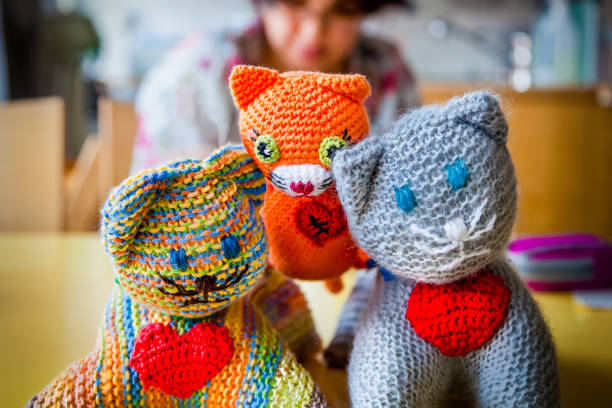
The bushfires raging across Australia have a devastating effect on our native animals.
While a record number of animals, both injured and orphaned, are being treated in Australia, people from all over the world, including France and The Netherlands, are knitting, crocheting, and sewing pouches for the animals to keep them calm and warm when they are taken into care.
This is the latest of many times when people have crafted crises.
Comforts of home
Both creators and receivers have long found comfort in the craft. It has also helped shape the fabric of society.
In 1912, the suffragettes made banners and clothes with embroidered designs to be displayed at their rallies to demand the right to vote.
The practice of crafting in a crisis continued into World War II, with Australian government departments issuing knitting patterns and guidelines for suitable garments that soldiers could wear to war. In World War II, Australian government departments issued knitting patterns and procedures to help soldiers create appropriate clothing for war.
More recently, knitting groups such as Knitting Nannas Against Gas are reviving the tradition of knitting being used for non-violent activism.
In 2017, the Women’s Electoral Lobby released the pattern for a pussy hat to show solidarity with the marches of women around the world.
Crafters are drawn to Australia’s animals in need.
Philip Island’s Knits for Nature began in response to oil spills that threatened penguins during the late 1990s and early 2000s. Knitters from around the world rallied in support of this cause and continued to donate.
Australia is currently experiencing a bushfire emergency that is early and severe, linked to global warming.
Kristie Newton, campaign manager for animal rescue group WIRES, says that the timing of the fires has made things worse for animal rescue groups:
Spring is the busiest season of the year. It’s spring, which is our busiest time of year.
Members of the community and organizations are mobilizing to knit or crochet marsupial pouches. They also make pouches with linings or wraps for abandoned joeys. WIRES received donations from Australia and NZ as well as the UK, USA, and Sweden.
Many hands
Jacqui Fink, a Sydney-based fiber artist, is helping to coordinate donations of pouches or linings for animal welfare groups. She agrees that “the fires are so large and horrific that people want to help as many animal as they can in any way that they can”.
Many teachers asked me to send patterns for the children to make pouches. The response from church groups has been incredible, and even the women’s prisons in South Australia have asked for information. Fink says, “I’ve received packages containing pouches and linings all across Australia.”
Newton says that WIRES has received numerous calls from schools asking for information on how to make pouches. The phone is ringing non-stop, with people offering help.
The cause is not only supported by the local craft community.
Fink says, “I have received over 10,000 emails, from people as far as Estonia, Finland and South Africa to Canada, Germany, New Zealand, asking for patterns to create pouches that will help our wildlife.”
It is an inexpensive and sustainable way to help. The pouches must be made of pure wool, and the linings must be cotton or flannelette.
We crafters are practical people. Fink says, “We love to work and have a lot of fabric and thread lying around our house.”
Woolen blankets or old cotton sheets can be used to make pouches and linings, saving them from landfill.
Create an agency
Crafting is often a popular activity during times of crisis, as it gives people a sense of purpose.
KKnitting, crocheting, and sewing are all proven to help reduce anxiety and cope with traumatic situations.
Making pouches to protect animals is a practical solution, even though the scale of Australian bushfires is overwhelming.
It’s a great way to give back, and the people who make it can be proud that they made something with their own hands, which will keep an animal warm during the night. Newton says, “That’s a lovely gift to give.”
The pouch and lining patterns are so basic that it’s an opportunity to learn new skills and carry on traditional crafts. Crafting pouches and liners can also allow kids to focus on something positive.
Debbie Downie, a youth health nurse from Kirwan State High School (Townsville), organized for students and their teachers to sew Koala Mittens during lunchtime. Parents and members of the local community also participated by donating fabrics or sewing with children. The children have now sewn more than 150 koala mitts for animals that were affected by bushfires.
Small acts of craft can be powerful in a time of crisis.
Fink says that the volunteers can sometimes feel alone and frustrated. But by rising with their craft, they will know there are people out there who care.
Newton agrees. “We have been overwhelmed by kindness and it helps us to keep going now and in the future.”
We can all echo the slogan of wartime: Stay calm and keep on crafting.
